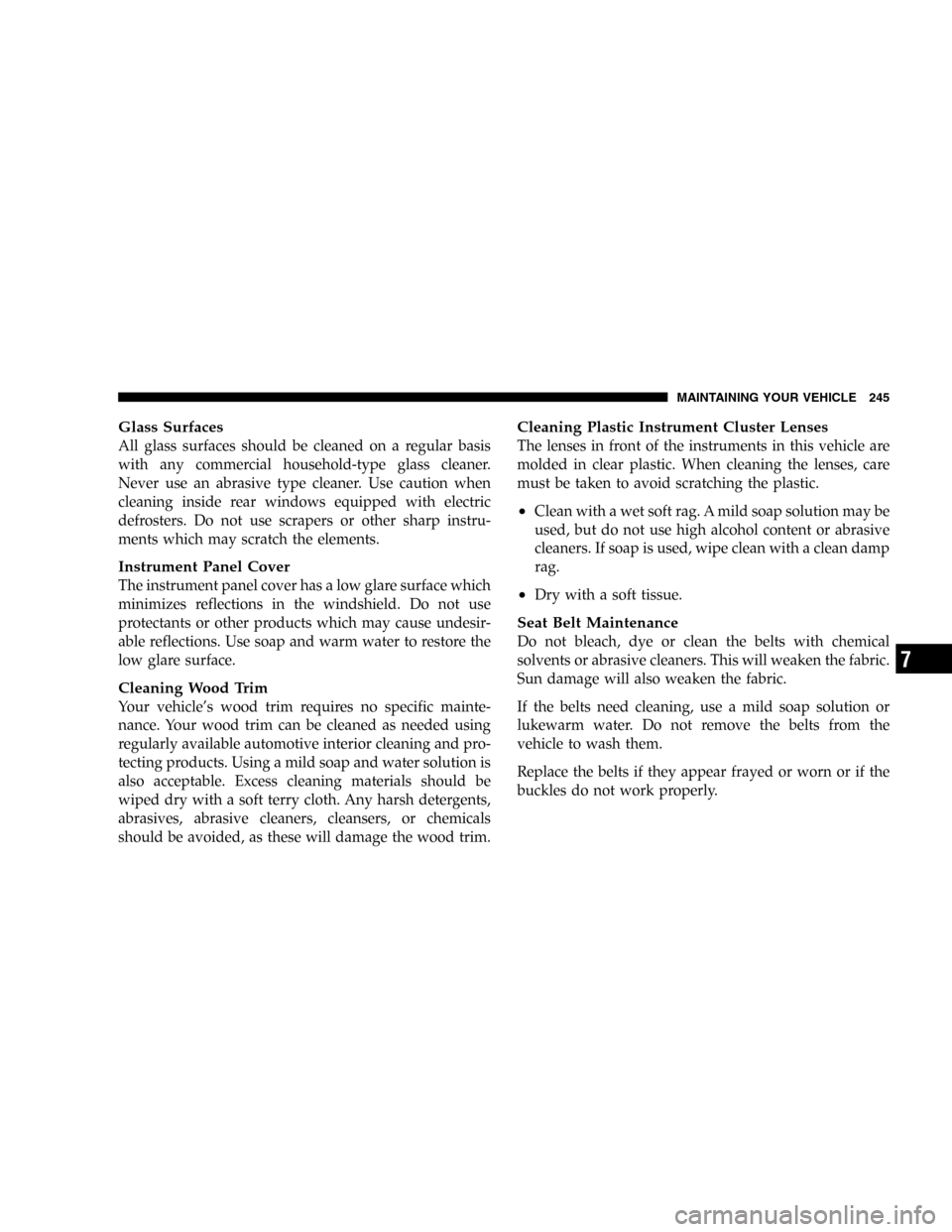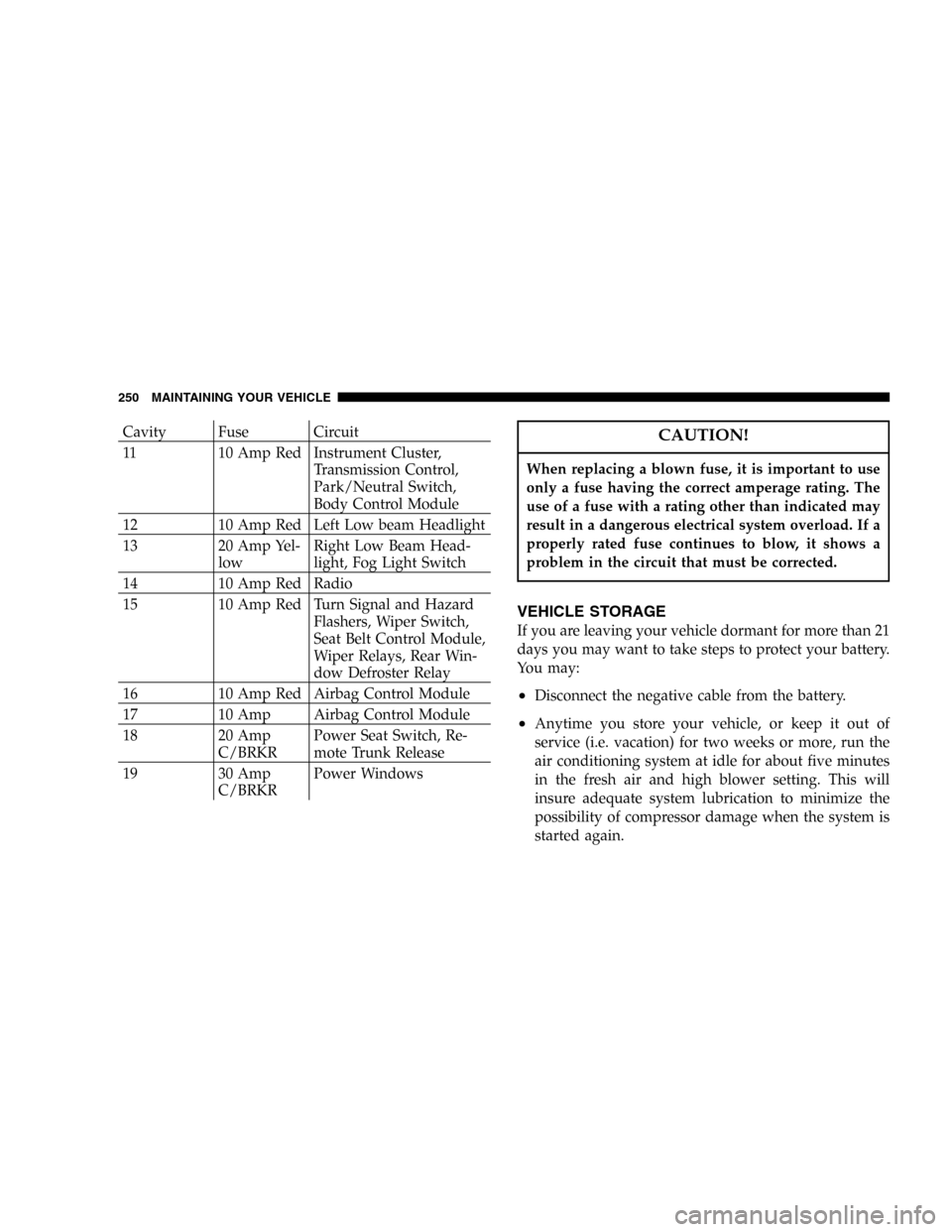Page 222 of 302

Engine Oil Filter Selection
All manufacturer’s engines have a full-flow type dispos-
able oil filter. Use a filter of this type for replacement. The
quality of replacement filters varies considerably. Only
high quality filters should be used to assure most efficient
service. Mopar Engine Oil Filters are high quality oil
filters and are recommended.
Drive Belts — Check Condition and Tension
At the mileage shown in the maintenance schedules,
check all drive belts for condition and proper tension.
Improper belt tension can cause belt slippage and failure.
Inspect the drive belts for evidence of cuts, cracks, or
glazing and replace them if there is any sign of damage
which could result in belt failure. If adjustment is re-
quired, adjust the belts according to the specifications
and procedures shown in the Service Manual.
Special tools are required to properly measure tension
and to restore belt tension to factory specifications. Also,
check belt routing to make sure there is no interference
between the belts and other engine components.
Spark Plugs
Spark plugs must fire properly to assure engine perfor-
mance and emission control. New plugs should be in-
stalled at the specified mileage. The entire set should be
replaced if there is any malfunction due to a faulty spark
plug. Check the specifications section for the proper type
of spark plug for use in your vehicle.
Engine Air Cleaner Filter
Under normal driving conditions, replace the air filter at
the intervals shown on Schedule “A”. If, however, you
drive the vehicle frequently under dusty or severe con-
ditions, the filter element should be inspected periodi-
cally and replaced if necessary at the intervals shown on
Schedule “B”.
222 MAINTAINING YOUR VEHICLE
Page 224 of 302

WARNING!
A hot exhaust system can start a fire if you park over
materials that can burn. Such materials might be
grass or leaves coming into contact with your ex-
haust system. Do not park or operate your vehicle in
areas where your exhaust system can contact any-
thing that can burn.
In unusual situations involving grossly malfunctioning
engine operation, a scorching odor may suggest severe
and abnormal catalyst overheating. If this occurs, stop
the vehicle, turn off the engine and allow it to cool.
Service, to the manufacturer’s specifications, should be
obtained immediately.To minimize the possibility of catalyst damage:
•Do not shut off the engine or interrupt the ignition
when the transaxle is in gear and the vehicle is in
motion.
•Do not try to start the engine by pushing or towing the
vehicle.
•Do not idle the engine with any spark plug wires
disconnected for prolonged period.
Engine Timing Belt
Replace the engine timing belt (2.4L Only) at the intervals
described in the appropriate maintenance schedule.
Crankcase Emission Control System
Proper operation of this system depends on freedom from
sticking or plugging due to deposits. As vehicle mileage
builds up, the Positive Crankshaft Ventilation (PCV) valve
and passages may accumulate deposits. If a valve is not
working properly, replace it with a new valve. DO NOT
ATTEMPT TO CLEAN THE OLD PCV VALVE!
Check ventilation hose for indication of damage or
plugging deposits. Replace if necessary.
224 MAINTAINING YOUR VEHICLE
Page 245 of 302

Glass Surfaces
All glass surfaces should be cleaned on a regular basis
with any commercial household-type glass cleaner.
Never use an abrasive type cleaner. Use caution when
cleaning inside rear windows equipped with electric
defrosters. Do not use scrapers or other sharp instru-
ments which may scratch the elements.
Instrument Panel Cover
The instrument panel cover has a low glare surface which
minimizes reflections in the windshield. Do not use
protectants or other products which may cause undesir-
able reflections. Use soap and warm water to restore the
low glare surface.
Cleaning Wood Trim
Your vehicle’s wood trim requires no specific mainte-
nance. Your wood trim can be cleaned as needed using
regularly available automotive interior cleaning and pro-
tecting products. Using a mild soap and water solution is
also acceptable. Excess cleaning materials should be
wiped dry with a soft terry cloth. Any harsh detergents,
abrasives, abrasive cleaners, cleansers, or chemicals
should be avoided, as these will damage the wood trim.
Cleaning Plastic Instrument Cluster Lenses
The lenses in front of the instruments in this vehicle are
molded in clear plastic. When cleaning the lenses, care
must be taken to avoid scratching the plastic.
•Clean with a wet soft rag. A mild soap solution may be
used, but do not use high alcohol content or abrasive
cleaners. If soap is used, wipe clean with a clean damp
rag.
•Dry with a soft tissue.
Seat Belt Maintenance
Do not bleach, dye or clean the belts with chemical
solvents or abrasive cleaners. This will weaken the fabric.
Sun damage will also weaken the fabric.
If the belts need cleaning, use a mild soap solution or
lukewarm water. Do not remove the belts from the
vehicle to wash them.
Replace the belts if they appear frayed or worn or if the
buckles do not work properly.
MAINTAINING YOUR VEHICLE 245
7
Page 250 of 302

Cavity Fuse Circuit
11 10 Amp Red Instrument Cluster,
Transmission Control,
Park/Neutral Switch,
Body Control Module
12 10 Amp Red Left Low beam Headlight
13 20 Amp Yel-
lowRight Low Beam Head-
light, Fog Light Switch
14 10 Amp Red Radio
15 10 Amp Red Turn Signal and Hazard
Flashers, Wiper Switch,
Seat Belt Control Module,
Wiper Relays, Rear Win-
dow Defroster Relay
16 10 Amp Red Airbag Control Module
17 10 Amp Airbag Control Module
18 20 Amp
C/BRKRPower Seat Switch, Re-
mote Trunk Release
19 30 Amp
C/BRKRPower WindowsCAUTION!
When replacing a blown fuse, it is important to use
only a fuse having the correct amperage rating. The
use of a fuse with a rating other than indicated may
result in a dangerous electrical system overload. If a
properly rated fuse continues to blow, it shows a
problem in the circuit that must be corrected.
VEHICLE STORAGE
If you are leaving your vehicle dormant for more than 21
days you may want to take steps to protect your battery.
You may:
•Disconnect the negative cable from the battery.
•Anytime you store your vehicle, or keep it out of
service (i.e. vacation) for two weeks or more, run the
air conditioning system at idle for about five minutes
in the fresh air and high blower setting. This will
insure adequate system lubrication to minimize the
possibility of compressor damage when the system is
started again.
250 MAINTAINING YOUR VEHICLE
Page 267 of 302
Miles 21,000 24,000 27,000 30,000 33,000 36,000
(Kilometers) (35 000) (40 000) (45 000) (50 000) (55 000) (60 000)
Change engine oil and engine oil filter, if not
replaced at 3 months.XXXXX X
Inspect theair cleaner filterand replace if re-
quired.*XXX X X
Replace theair cleaner filter.X
Inspect and check tension for power steering
belt (2.4 Liter Engine). Adjust or replace if re-
quired.X
Inspect the front and rear brake pads, linings,
rotors, rear drums and shoes.XX
Check and replace, if necessary, thePCV
valve.*X
Replace thespark plugson 2.4 liter engine. X
Rotate the tires. X X X
SCHEDULE “B” 267
8
M
A
I
N
T
E
N
A
N
C
E
S
C
H
E
D
U
L
E
S
Page 269 of 302
Miles 57,000 60,000 63,000 66,000 69,000 72,000
(Kilometers) (95 000) (100 000) (105 000) (110 000) (115 000) (120 000)
Change engine oil and engine oil filter, if not re-
placed at 3 months.XXXXX X
Inspect theair cleaner filterand replace if neces-
sary.*XXXXX
Replace theair cleaner filter.X
Inspect and check tension for power steering belt
(2.4 Liter Engine). Adjust or replace if required.X
Inspect the front and rear brake pads, linings, ro-
tors, rear drums and shoes.XX
Replace theignition cableson 2.4 liter engine. X
Replace the accessory drive belts on the 2.7 liter
engine.X
Replace thespark plugson the 2.4 liter engine. X
Check and replace, if necessary, thePCV valve.*‡ X
Change the automatic transmission fluid and fil-
ter.�X
Rotate the tires. X X X
Flush and replace engine coolant at 60 months, if
not done at 100,000 miles.X
SCHEDULE “B” 269
8
M
A
I
N
T
E
N
A
N
C
E
S
C
H
E
D
U
L
E
S
Page 270 of 302
Miles 75,000 78,000 81,000 84,000 87,000 90,000
(Kilometers) (125 000) (130 000) (135 000) (140 000) (145 000) (150 000)
Change engine oil and engine oil filter, if not
replaced at 3 months.XXXXX X
Inspect theair cleaner filterand replace if
necessary.*XXXXX
Replace theair cleaner filter.X
Inspect and check tension for power steering
belt (2.4 Liter Engine). Adjust or replace if re-
quired.X
Replace theengine timing belton 2.4 liter
engine.X
Inspect the front and rear brake pads, linings,
rotors, rear drums and shoes.X
Replace thespark plugson 2.4 liter engine. X
Check and replace, if necessary, thePCV
valve.X
Rotate the tires. X X X
270 SCHEDULE “B”
8
M
A
I
N
T
E
N
A
N
C
E
S
C
H
E
D
U
L
E
S
Page 271 of 302
Miles 93,000 96,000 99,000 100,000 102,000 105,000
(Kilometers) (155 000) (160 000) (165 000) (170 000) (175 000) (180 000)
Change engine oil and engine oil filter, if not
replaced at 3 months.XXX X X
Inspect theair cleaner filterand replace if
necessary.*XXX X X
Inspect the front and rear brake pads, linings,
rotors, rear drums and shoes.X
Replace thespark plugson the 2.7 liter en-
gine.X
Check and re-tension accessory drive belts on
2.7 liter engine.X
Replace the accessory drive belts on 2.4 liter
engine.X
Rotate the tires. X X X
Flush and replace the engine coolant, if not
replaced at 60 months.X
SCHEDULE “B” 271
8
M
A
I
N
T
E
N
A
N
C
E
S
C
H
E
D
U
L
E
S